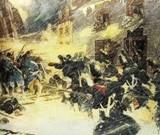Battle of Quebec - Conflict:
The Battle of Quebec was part of the American invasion of Canada during the American Revolution.
Battle of Quebec - Date:
The assault on Quebec was defeated on the night of December 30/31, 1775.
Armies & Commanders:
Americans
Brigadier General Richard Montgomery
Colonel Benedict Arnold
Colonel James Livingston
900 men
British
Governor Sir Guy Carleton
1,800 men
Battle of Quebec - Background:
|
|
Beginning in September 1775, the invasion of Canada was the first major offensive operation conducted by American forces during the war. Initially led by Major General Philip Schuyler, command of the invading force was turned over to Brigadier General Richard Montgomery when the former fell ill. Departing Fort Ticonderoga on September 16, Montgomery advanced up Lake Champlain with 1,700 militia. Arriving at Fort Jean three days later, he laid siege and forced the garrison to surrender on November 3. Pressing on, the Americans occupied Montreal without a fight on November 28.
To the east, a second American expedition fought its way north through the Maine wilderness. Organized by Colonel Benedict Arnold, this force of 1,100 men had been picked from the ranks of General George Washington's Continental Army outside Boston. Proceeding from Massachusetts to the mouth of the Kennebec River, the expedition soon encountered hardship when it became clear that their maps were faulty. Lacking adequate supplies, starvation set in and only 600 eventually reached the St. Lawrence. Approaching Quebec, it quickly became clear that Arnold lacked the men needed to take the city.
Battle of Quebec - British Preparations:
Withdrawing to Pointe aux Trembles, Arnold was forced to wait for reinforcements. On December 2, Montgomery descended the river with 300 men and united with Arnold. Together the two planned their attack on the city. Within its walls, the Governor-General of Canada, Sir Guy Carleton possessed a garrison of 1,800 regulars and militia. Aware of American activities in the area, Carleton made efforts to enhance the city's formidable defenses by erecting a series of barricades. To assault the city, Montgomery and Arnold planned on advancing from two directions.
Battle of Quebec - The Americans Advance:
Montgomery was to attack from the west, moving along the St. Lawrence waterfront, while Arnold was to advance from the north, marching along the St. Charles River. The two were to reunite at point where the rivers joined and then turn to attack the city wall. Moving out on December 30, the assault began after midnight on the 31st during a snowstorm. Advancing past the Cape Diamond Bastion, Montgomery's force pressed into the Lower Town where they encountered the first barricade. Forming to attack the barricade's 30 defenders, the Americans were stunned when the first British volley killed Montgomery.
Battle of Quebec - A British Victory:
In addition to killing Montgomery, the volley struck down his two chief subordinates. With their general down, the American attack faltered and the remaining officers ordered a withdrawal. Unaware of Montgomery's death and the attack's failure, Arnold's column pressed on from the north. Reaching the Sault au Matelot, Arnold was hit and wounded in the left ankle. Unable to walk, he was carried to the rear and command was transferred to Captain Daniel Morgan. Successfully taking the first barricade they encountered, Morgan's men moved into the city proper.
With Montgomery's column repulsed, Morgan became the focus of the defender's activities. British troops counterattacked in the rear and retook the barricade before moving through the streets to surround Morgan's men. With no options remaining, Morgan and his men were forced to surrender.
Battle of Quebec - Aftermath:
The Battle of Quebec cost the Americans 60 dead and wounded as well as 426 captured. For the British, casualties were a light 6 killed and 19 wounded. Though the assault failed, American troops remained in the field around Quebec. Rallying the men, Arnold attempted to lay siege to the city. This proved increasingly ineffective as men began to desert following the expiration of their enlistments. Though he was reinforced, Arnold was forced to fall back following the arrival of 4,000 British troops under Major General John Burgoyne. After being defeated at Trois-Rivières on June 8, 1776, American forces were forced to retreat back into New York, ending the invasion of Canada.



